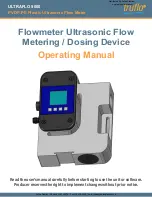
With the set command, you can adjust the display format results for various
measurements, making them easier to read and interpret.
Formatting of source lines, symbol display selection and width, and update after
measurement can be modified to your needs.
The display command uses the set command specifications to format measurement
results for the display window.
Another option to the set command, <ENV_VAR> = <VALUE>, allows you to
set and export system variables.
The default display format parameters are the same as those set by the commands:
set update
set source off symbols off
You can return the display format to this state by simply using the command:
set default
default
This option restores all the set options to their default settings.
demmuer
on
This option turns on the deMMUer. Addresses on the
emulation bus will be reverse-translated (physical to logical)
before being supplied to the analyzer. Reverse translations will
be made according to the setup that was present in the MMU at
the time you entered your last load demmuer command.
off
This option turns off the deMMUer. Addresses on the
emulation bus will be supplied directly to the analyzer without
translation.
<ENV_VAR>
Specifies the name of an environment variable to be set within the HP 64000-UX
environment or the system environment.
=
The equals sign is used to equate the <ENV_VAR> parameter to a particular value
represented by <VALUE>.
Chapter 11: Emulator Commands
set
472
Summary of Contents for 64783A
Page 30: ...xxx ...
Page 31: ...Part 1 Quick Start Guide 1 ...
Page 33: ...1 Getting Started 3 ...
Page 70: ...40 ...
Page 75: ...Part 2 Using The Emulator 45 ...
Page 140: ...110 ...
Page 141: ...4 Using the Emulator How to control the processor and view system resources 111 ...
Page 227: ...5 Using the Emulation Bus Analyzer How to record program execution in real time 197 ...
Page 290: ...260 ...
Page 331: ...8 Configuring the Emulator 301 ...
Page 382: ...352 ...
Page 383: ...9 Solving Problems What to do when the emulator doesn t behave as expected 353 ...
Page 397: ...Part 3 Reference 367 ...
Page 399: ...10 Using Memory Management Understanding logical and physical emulation and analysis 369 ...
Page 429: ...11 Emulator Commands The command syntax reference for the emulator softkey interface 399 ...
Page 443: ...copy Chapter 11 Emulator Commands copy 413 ...
Page 451: ...display Chapter 11 Emulator Commands display 421 ...
Page 457: ...DISPLAY MEMORY Chapter 11 Emulator Commands DISPLAY MEMORY 427 ...
Page 461: ...DISPLAY MMU Chapter 11 Emulator Commands DISPLAY MMU 431 ...
Page 464: ...DISPLAY TRACE Chapter 11 Emulator Commands DISPLAY TRACE 434 ...
Page 480: ...modify Chapter 11 Emulator Commands modify 450 ...
Page 501: ...set Chapter 11 Emulator Commands set 471 ...
Page 514: ... SYMB Chapter 11 Emulator Commands SYMB 484 ...
Page 582: ...552 ...
Page 583: ...13 Setting X Resources 553 ...
Page 598: ...568 ...
Page 606: ...576 ...
Page 613: ...16 Specifications and Characteristics 583 ...
Page 627: ...Part 4 Concept Guide 597 ...
Page 629: ...17 X Resources and the Graphical User Interface 599 ...
Page 639: ...Part 5 Installation and Service Guide 609 ...
Page 697: ...19 Installation and Service 667 ...
Page 746: ...Chapter 19 Installation and Service Verifying the Installation 716 ...
Page 755: ...20 Installing Updating Emulator Firmware 725 ...
Page 762: ...732 ...
Page 778: ...748 ...
Page 810: ...X server 554 604 X Window System 54 Index 780 ...
















































